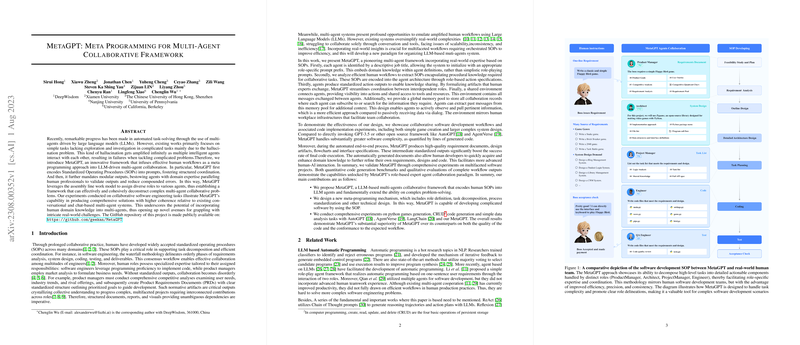An Overview of MetaGPT: Meta Programming for a Multi-Agent Collaborative Framework
The paper "MetaGPT: Meta Programming for a Multi-Agent Collaborative Framework" introduces MetaGPT, a novel meta-programming framework designed to address limitations in current LLM-based multi-agent systems. The authors propose a method integrating Standardized Operating Procedures (SOPs) to manage complex problem-solving through a collaborative approach among specialized agents. This methodology aims to mitigate inconsistencies and errors in task execution, ultimately enhancing the performance and reliability of LLM-based multi-agent systems.
Introduction
LLM-based autonomous agents offer significant potential for enhancing human workflows. However, current systems often struggle with logic inconsistencies and inaccuracies due to cascading hallucinations when chaining LLMs. The proposed MetaGPT framework aims to overcome these limitations by adopting human methodologies, particularly SOPs, to structure multi-agent collaborations. This structured approach allows each agent to contribute domain-specific expertise, providing a more reliable and coherent solution to complex tasks.
Framework and Methodology
MetaGPT leverages an "assembly line" paradigm where tasks are broken down into specific roles assigned to various agents. Key roles within the framework include Product Manager, Architect, Project Manager, Engineer, and QA Engineer. Each role follows defined SOPs, contributing structured outputs at different stages of the task execution. This methodology ensures that intermediate results are thoroughly verified, significantly reducing errors and enhancing the overall coherence of the solution.
Agents in SOPs
The framework outlines specific role specializations, where each agent is responsible for particular aspects of a problem. For instance, the Product Manager creates Product Requirements Documents (PRDs), while the Architect designs system interfaces and flow diagrams. The Engineer generates and executes code, and the QA Engineer ensures code quality through rigorous testing. This division of labor, coupled with structured communication interfaces, enhances the efficiency and accuracy of the multi-agent collaboration.
Communication Protocol
MetaGPT employs a publish-subscribe mechanism for efficient information sharing among agents. All structured outputs are stored in a global message pool, allowing agents to access relevant information as needed. This system reduces the complexity and potential for information loss associated with one-to-one communication among numerous agents.
Iterative Programming with Executable Feedback
A crucial innovation in MetaGPT is the executable feedback mechanism. After generating initial code, the Engineer executes and debugs it, iteratively refining the code based on runtime feedback. This process significantly improves the quality of the final code, addressing issues that may be overlooked during static reviews.
Experimental Results
MetaGPT was evaluated against established benchmarks such as HumanEval and MBPP, demonstrating superior performance with state-of-the-art Pass@1 rates of 85.9% and 87.7%, respectively. Moreover, the framework was tested on a self-generated SoftwareDev dataset, encompassing diverse and complex software development tasks. MetaGPT outperformed other frameworks such as AutoGPT, LangChain, and AgentVerse in terms of executability, cost-efficiency, and human revision requirements.
Numerical Results
In the SoftwareDev evaluations, MetaGPT achieved an average executability score of 3.75 out of 4, with significantly lower human revision costs compared to alternative approaches. The framework also showed efficient token usage and execution times, underscoring its practical applicability in real-world scenarios.
Implications and Future Developments
The introduction of MetaGPT has practical implications for developing more reliable and efficient LLM-based multi-agent systems. By incorporating SOPs and structured communication interfaces, the framework addresses the challenges of maintaining coherency and reducing errors in complex problem-solving tasks. The executable feedback mechanism further enhances the robustness of the generated solutions.
Future research could explore self-improvement mechanisms, where the system learns and optimizes its SOPs and communication protocols based on past experiences. Additionally, implementing an economy-based framework for agent collaboration, similar to the Natural Language-Based Society of Mind (NLSOM), could further enhance the adaptability and efficiency of such systems.
Conclusion
MetaGPT presents a significant advancement in the meta-programming of multi-agent LLM-based systems, showcasing substantial improvements in both theoretical and practical aspects of collaborative AI frameworks. By adopting human-like workflows and robust verification mechanisms, MetaGPT sets a new benchmark for reliability and performance in automated problem solving. This work paves the way for future innovations in AI-driven multi-agent systems, emphasizing the importance of structured methodologies and iterative improvements.
